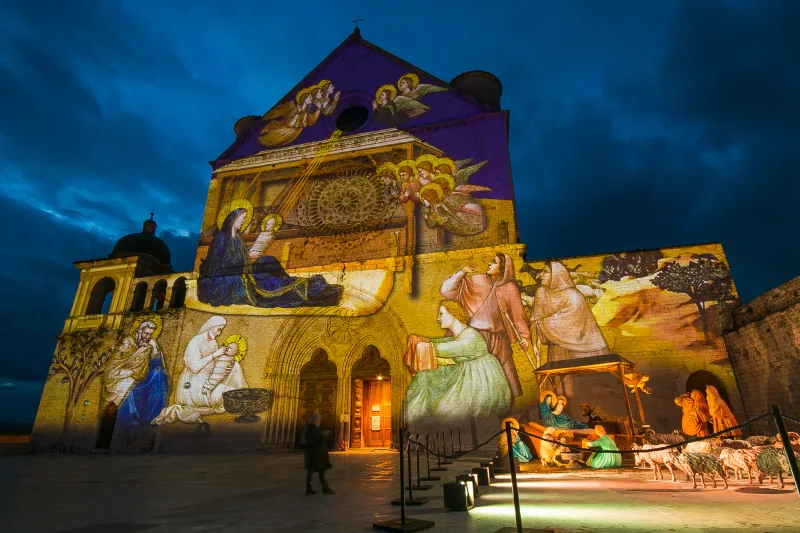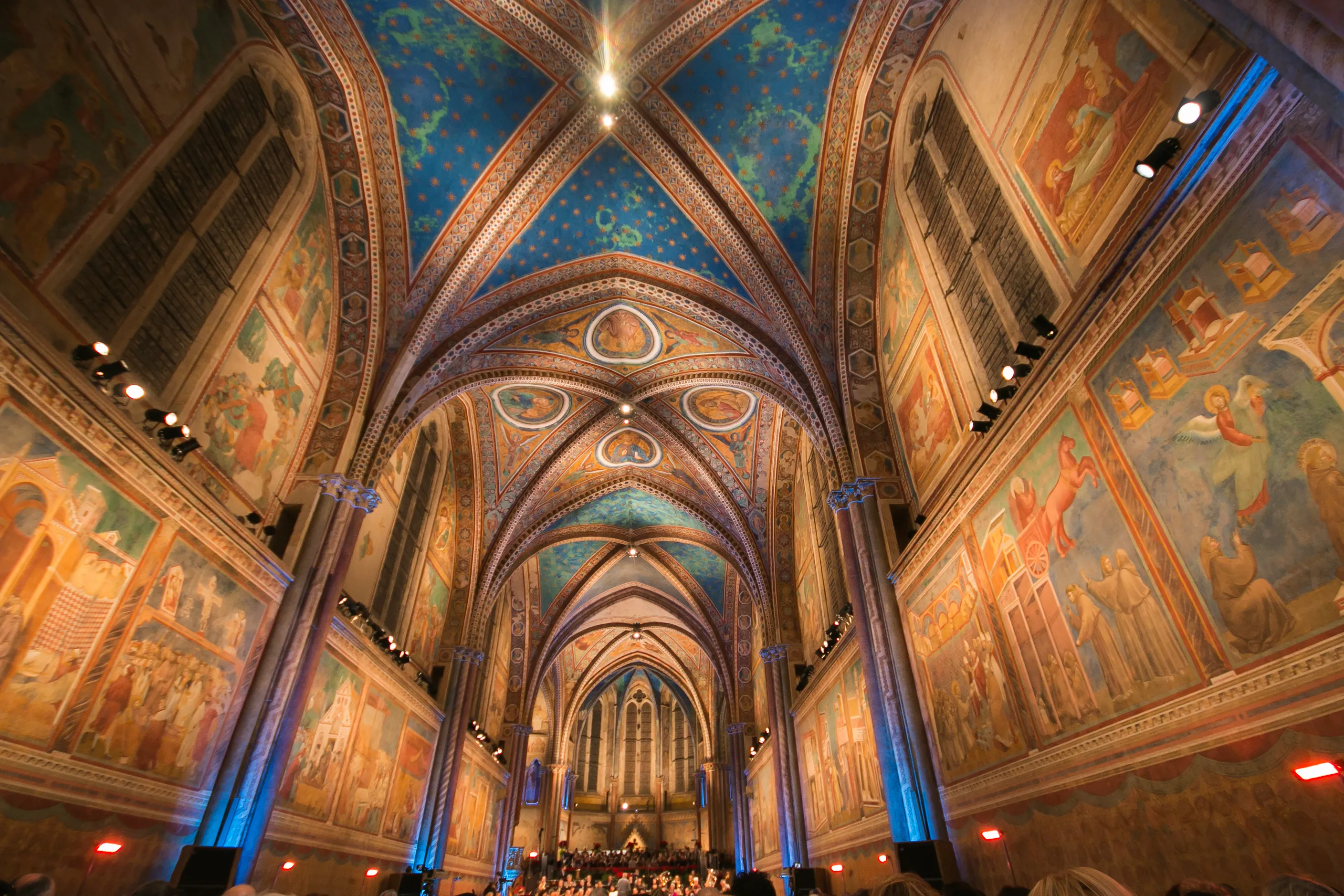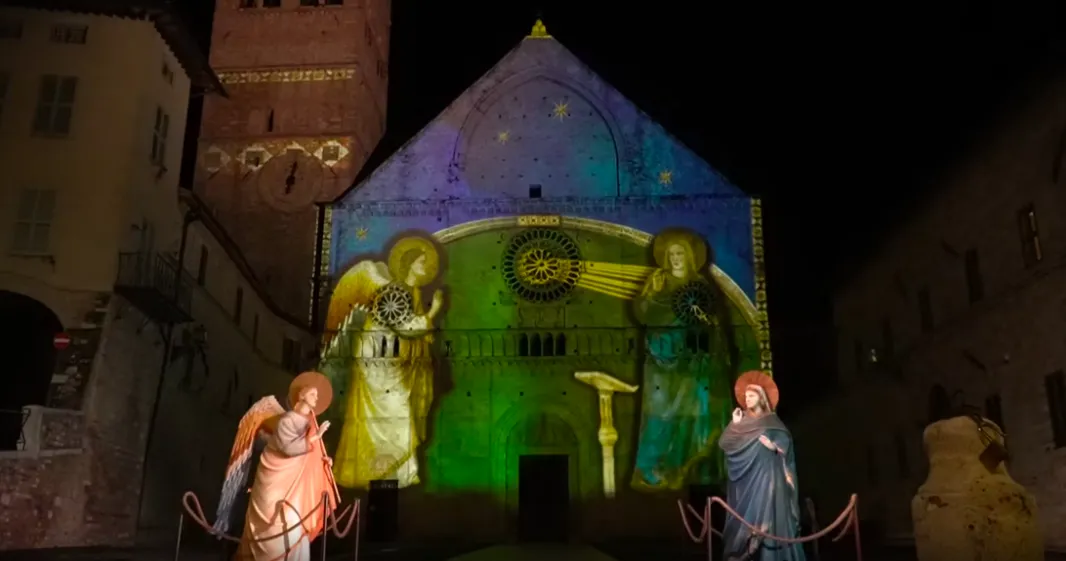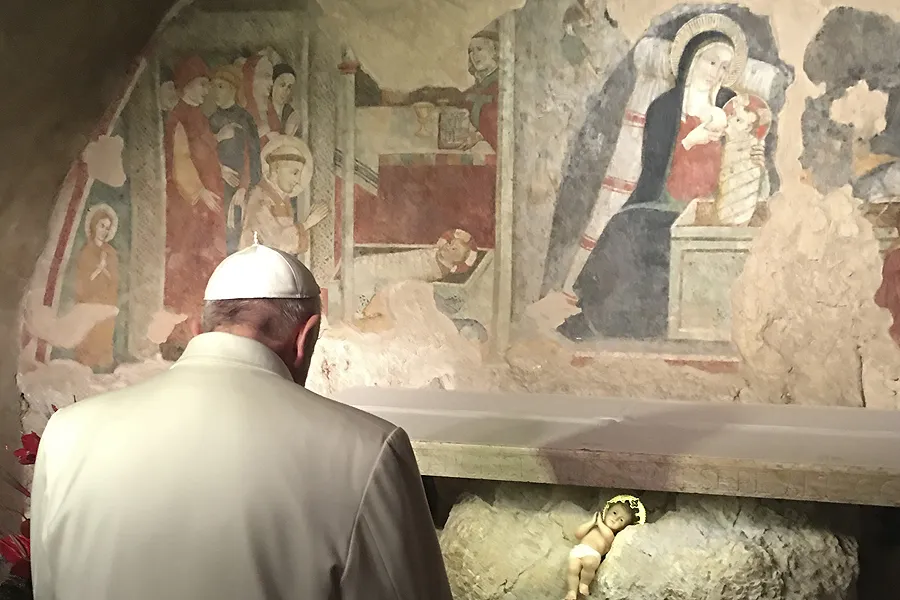
We Three Kings of Orient are,
Bearing gifts we traverse afar. . . .
Who were these gift-bearing kings, these Wise Men of the East? What has their mission meant to Christians across the ages?
The Wise Men—not yet called kings—make only a single appearance in Holy Scripture. St. Matthew’s Gospel (Mt 2:1-12) tells of their arrival in Jerusalem shortly after the birth of Jesus. They have come seeking the newborn King of the Jews because they had seen his star rise in the East. Herod, the current ruler, knows nothing of an upstart princeling but learns that prophecies place him in Bethlehem. Herod directs the Wise Men to search there for the Child and keep him informed. Following their star, the Wise Men find Jesus with his Mother. They worship him and bestow gifts of gold, frankincense, and myrrh. Warned by an angel, they do not reveal the Child’s location to jealous Herod but return secretly to their own land.
In ancient texts of Scripture the Wise Men are Magoi in Greek and Magi in Latin. The singular form, Magos/Magus, is the source of our English word “magician” but had multiple meanings in Biblical times. A magus could be a Zoroastrian priest from Persia, an occultist, a magician, or a charlatan. Because the New Testament Magi study the stars, their mystic wisdom presumably includes astrology. Hence some recent Bible translations call them “astrologers,” a less evocative term than the more traditional “Wise Men.”
Some early Christians equated the Magi with Chaldean star-readers from Babylon, masters of the occult familiar throughout the Roman Empire. St. Justin Martyr and Tertullian thought they were Arabians but most believers in Patristic times took their Persian origin for granted.
Church Fathers were quick to see deeper symbolism in this curious episode, first through its Old Testament parallels. Origen suggested that the Magi were descendants of the pagan prophet Balaam who had predicted that “a star shall rise out of Jacob” (Num. 24:17). Other Old Testament figures including the priest-king Melchizedek (Gen. 14:18-20), the generous Queen of Sheba (1 Kgs. 10), and the faithful Three Young Men in the Fiery Furnace (Dan. 3) were also seen as counterparts of the Wise Men from the East.
Strangers who worship the new King of Judah and bring gifts fulfill Messianic prophecies. “The kings of Tarshish and the Isles shall offer gifts; the kings of Arabia and Seba shall bring tribute” (Ps. 72:10). “All they from Sheba shall come, bearing gold and frankincense, and proclaiming the praises of the Lord.” (Isa. 60:6) Because the Scriptures speak of tributary kings, Tertullian called the Magi kings. Origen specified that they numbered three to match their gifts and their named kingdoms. St. John Chrysostom preached about twelve Wise Men but his interpretation failed to find favor.
These foreigners, the first Gentiles to see the Light, recognize what Herod and the Temple priesthood cannot: the newborn Savior. The wealthy, learned, alien Magi of St. Matthew’s Gospel complement the poor, ignorant, local shepherds of St Luke’s Gospel. Foreshadowing the universality of the Church, these Gentiles and Jews worship God Incarnate to show that salvation is offered to all men.
St. Irenaeus of Lyons was the first Church Father to equate the Wise Men’s gifts of gold, frankincense, and myrrh with Christ’s roles as King, God, and Sacrifice. This became the dominant reading, still familiar through the beautiful Victorian Christmas carol, “We Three Kings of Orient Are.” But other interpretations also appeared in which the gifts stand for the virtues of faith, chastity, and purity of heart or else for almsgiving, prayer, and mortification.
The Christ Child’s adoration by the Magi is known as his Epiphany (“Manifestation”) because it announces his mission to redeem the world. Ancient Christendom spoke of multiple manifestations (initially including the Nativity) by linking the revelation of the newborn Christ with his later baptism in the Jordan and his first miracle at Cana. These key points in his mission, which were imagined to have occurred on the same calendar date, also used to be celebrated in the pre-Vatican II Roman breviary. As an Epiphany antiphon at Vespers proclaims, “We honor the holy day adorned with three miracles: today the star led the Magi to the crib: today wine was made from water for a wedding: today Christ willed to be baptized by John in the Jordan.” In medieval Europe, Epiphany was often connected with the miracle of the loaves and fishes and with the raising of Lazarus.
The traditional date of Epiphany is January 6th although in some places, including the United States, the feast is transferred to the nearest Sunday. Epiphany is an older feast than Christmas for it is attested in the East from the first half of the third century, at least 75 years before Christmas is mentioned as a holy day in Rome.
By the late fourth century Christmas was also being celebrated in the East so Epiphany lost its Nativity connection there. The Baptism of the Lord became the chief focus of Epiphany and the subject of its special feast day icon. The public manifestation of Christ as the Divine “beloved Son” outranked the private homage of the Magi, who were relegated to the background of Nativity icons.
Nevertheless, the Adoration of the Magi has been a popular subject for artists since Late Antiquity. The earliest surviving examples are catacomb paintings from the second and third centuries and carvings on stone coffins from the first half of the fourth century. On the coffins, three nearly identical Magi process toward the enthroned Madonna and Child. Their gifts allude to the alms the deceased person had given in his lifetime. Famous mosaics depicting the Magi also appear in the churches of S. Maria Maggiore in Rome (440) and S. Apollinare Nuovo in Ravenna (561). The Magi are represented in exotic “Eastern” garb, wearing tunics, leggings, and soft peaked caps. They observe imperial Roman court etiquette by presenting their gifts with covered hands or on trays. The gold is often in the form of a royal wreath and the star appears as an emblem of divine kingship.
By the tenth century, Western artists are portraying the Wise Men with crowns. They grow distinguishable because they have come to stand for the three ages of man, the three known continents of the Old World, and three races descended from the sons of Noah. In later medieval art the Magi lay aside their crowns to interact with the Christ Child and receive his blessing. Their garments become increasingly fantastic and their faces are often modeled on contemporary rulers. By the fourteenth century, the youngest Magus is portrayed as a black African in many Northern European paintings. In subsequent centuries, other racial types joined the trio, including East Indians, Asians, Incas, and Canadian Indians, so that the Wise Men could represent all nations.
The thirteenth century Golden Legend gives the Magi’s names in Greek as Apellius, Amerius, and Damascus; in Hebrew as Galgalat, Malgalat, and Serchin; and in Latin as Caspar, Balthasar, and Melchior—the favorite set. There are inconsistencies about which Magus is which but in Germanic lands, Casper (gold) is elderly; Melchior (frankincense) is middle-aged; and Balthasar (myrrh) is young. The gifts are presented in order of age.
The center of the Magi’s cult is Cologne. The cathedral there boasts a splendid golden shrine holding their relics that has drawn swarms of pilgrims since the twelfth century. The Kings’ protection is traditionally invoked against travel dangers, plague, fever, and sudden death. Their initials C+M+B form a protective acronym for Christus mundum benedicat (“Christ blesses the world”). The faithful carry this symbol on holy cards or chalk it over their doors to ward off evil.
The alleged remains of the Magi are claimed to have been discovered in the East by St. Helena and brought to Milan in 400, whence they were looted by Frederick Barbarossa in 1162 and given to Cologne. Historian Patrick Geary has argued persuasively that Milan never had any relics of the Wise Men. Yet the bones in the shrine were wrapped in genuine purple silk from St. Helena’s lifetime so some ancient parties unknown have been passing as the Magi for eight centuries.
Regardless of authenticity, the Three Holy Kings have had great cultural impact on Cologne as the city’s male patron saints. Their crowns appear on the arms and banner of the city as well as on the seals of her archbishop and university. The Magi themselves bear heraldic arms. Caspar’s are a golden star and crescent on a blue field; Melchior’s six gold stars on a blue field, and Balthasar’s a red-clad Moor holding a lance with pennant on a golden field.
Thus Scripture and legend have combined to honor the Wise Men of the East as universal symbols of mankind adoring God Incarnate. May these first pilgrims who traveled by the light of a star “guide us to the Perfect Light.”
(Originally published in the Catholic Herald newspaper, January 2007, and at CWR on January 6, 2019. Reprinted by permission of the author.)
If you value the news and views Catholic World Report provides, please consider donating to support our efforts. Your contribution will help us continue to make CWR available to all readers worldwide for free, without a subscription. Thank you for your generosity!
Click here for more information on donating to CWR. Click here to sign up for our newsletter.











Any support for the theory that the Wise Men from Persia or Babylon had learned about a coming Messiah from the ten tribes who had been scattered into exile from the Northern Kingdom, by the Assyrian invasion in 721 B.C.?
Added to this plausible connection, and regarding astrology and a “star” (“…Balaam who had predicted that ‘a star shall rise out of Jacob;’” Num. 24:17, above), Michael B. Molnar, an astronomer and former manager of the Physics Instructional Labs at Rutgers University, proposes and demonstrates a very credible theory–the conjunction of the planets Jupiter and Saturn and with Aires in 6 B.C. (“The Star of Bethlehem: The Legacy of the Magi,” Rutgers University Press, 2000).
Molnar works from a rare star symbol found on numismatic coins from that period (e.g., ca A.D. 5-11 around the time when Quirtimius was governor of Syria and who served as Antioch’s governor from A.D. 6 to after A.D.7; author’s coin collection), AND much more thoroughly from computer simulations of the cosmos for that period (illustrated and reported in detail in his book). To astrologers, how did the sky look back then?
Interestingly, due to the yearly rotation of the earth around the sun, the conjunction would have appeared twice, six months apart and from opposite ends of the earth’s circular path. And, would have appeared to move/retrograde from its first location, now farther into in the western night sky. Incidentally and realistically, giving time to prepare for a long journey, assemble a caravan and travel overland from the East, conferring along the way, to where the star was now fixed over Bethlehem.
Insightful.
If I recall correctly, Michael B. Molnar’s theory treats the Star of Bethlehem as an astrological and astronomical phenomenon, more readily observable to learned men with knowledge of star charts, rather than a purely astronomical one observable to anyone with a clear view of the night sky at the time of our Savior’s birth.
The distinct advantage of Molnar’s theory is that it explains why angels were apparently needed to announce the birth to the shepherds. If something distinctly unusual in the night sky was able to be viewed by anyone, it would not have required angelic announcement.
I noticed this aspect of the Star of Bethlehem when I was a child. I decided (not yet familiar with the term “prudence”) to keep my mouth shut about it. If only I had done as well with prudence later.
Yes, “an astrological and astronomical phenomenon”…Astrology and astronomy were not differentiated until the 17th century. Likewise, alchemy and chemistry did not become separate disciplines until the 18th century…
And, in our self-inflated Scientific Era and regarding the inner universe, leftist political ideology and elementary embryology are still much conflated.
So many astronomers associated with the story, ancient and modern. My layman’s opinion is that men even of that far off time knew the difference between a star and a [planetary] conjunction, and would never have interchanged the labels.
And, Dec 25th to Jan 6th is much too short a time to accommodate the ‘two year olds’ of Matthew.
More tradition/magisterium vs. Scripture. God’s word wins, as always.
It’s a Solemnity and not a Feast. Liturgically there is a difference between a Solemnity and a Feast
A liturgical Solemnity is ranked higher than a Feast. In this day and age in America, the “feast” defines the thing. Americans like frivolity and McDonalds’ Happy Meal. Sad. Judgment Day arrives too soon for some; it’s too solemn. Myrhh is best not faced.
And your point relates to the average believer’s daily life in what practical way?
Historical factual accuracy furthers truth.
For a homiletic approach to the Solemnity of Epiphany, Carl Olson’s is good. Also, Catholic.com informs:
After the magi visited Jesus, they are warned in a dream not to return to Herod, and “departed for their country by another way” (Mt 2:12).
St. Leo the Great wrote: “Christian, recognize your dignity and, now that you share in God’s own nature, do not return to your former base condition by sinning. Remember who is your head and of whose body you are a member. Never forget that you have been rescued from the power of darkness and brought into the light of the Kingdom of God.”
An encounter with the true King of the Jews changes us forever. We might travel back to our country, but it’s no longer the familiar home. We might again inhabit old places, but we no longer truly live there. Perhaps we go back to work, to school or to college, but we are different; things are different. The old self is left behind, the new self journeys onward into the new night devoid of darkness. The illumination of the Star guides our every step and movement;…ETC.
Wishing you enlightened travels in the New Year.
Well said.